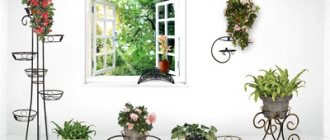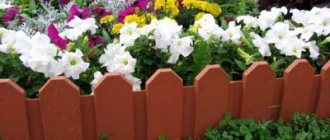Decorating the house with flowers
Obsolete large armfuls of flowers, sheaf bouquets... The accumulation of plants only distracts from the beauty and charm of each individual flower. It is best to make bouquets of an odd number of flowers (3, 5, 7) and complement them with several sprigs of greenery.
There are many options for selecting plants for bouquets. However, those flowers, herbs, leaves, and twigs that are arranged freely and naturally in vases are especially good.
A beautiful bouquet, like music, conveys the mood: bright, variegated, with lush flowers - like a ringing, joyful, festive song, and a bouquet of modest flowers in soft, close tones is like a gentle melody.
Green miracle on the wall
Many people have always liked indoor plants. They decorated spacious houses, small apartments and even personal plots. Often, greens were grown in pots that were placed on windows, floors, or outside. There were also those who hung flowerpots on the walls, attaching them to metal structures.
A modern structure, the living wall is a vertical hanging garden attached to a building.
Unlike facade green decorations, the roots of living wall plants are in a special tank.
The greens receive moisture and fertilizer from the vertical structure rather than from the soil. You can hang a great variety of indoor flowers on the structure. Such a living wall of plants in an apartment brings invaluable benefits to residents:
- cleansing the room atmosphere;
- humidification of dry air;
- absorption of unpleasant odors;
- original shade from the summer sun.
In addition, growing and caring for flowers on a phyto-wall is much easier than on windows and in pots. Especially when the flowerpots are located behind curtains, where they are completely invisible and inconvenient to water or spray. And if the windows of the apartment face north, then due to lack of sunlight, the plants often get sick. That is why “hanging gardens” are a wise solution for lovers of indoor plants.
A selection of photos of a living wall in the interior:
How to choose a flower vase
The charm and beauty of the bouquet will be emphasized by a well-chosen vase that does not compete with the flowers with the brightness of its colors. Its shape and color should be harmoniously combined with the plants. The beauty of daffodils, tulips, carnations, roses and irises can be emphasized with a wide, low vase (if there are many flowers) or a tall, narrow one - for one or two flowers, decorated with a green twig or 1-3 leaves.
For blue delphiniums and large roses, dark-colored vases or crystal vases with an extended top are suitable. Light peonies stand out well in large, bulbous vases with a soft bluish green color.
Dahlias are very graceful and stable to cut. Although they are small, this even enhances the decorative effect of the bouquet. Bouquets of them and several sprigs of greenery will decorate the dining table.
In the bedroom, on the dressing table, or on the desk, it is better to place miniature bouquets in flat vases, crystal rosettes or flowers such as pansies and daisies. Bright boutonnieres of 2-3 small slender flowers and a sprig of greenery will successfully complement the decoration of a capricious shaped branch or tinder mushroom.
In the spring, 1-2 branches of hazel or birch that have just opened their “earrings”, and 1-2 daffodils in a spherical crystal vase look beautiful and tender. In such a vase you can put a branch of echoria and red lanterns.
On the dining table, it is better to place flowers in low dishes. When creating bouquets for the table, it is advisable to take into account the color of the tablecloth. If it is variegated, then it is better to choose monochromatic flowers, or vice versa.
Create a green masterpiece with your own hands
Due to the fact that each person has his own taste and preferences, many are not satisfied with the standard “gardens” from the store. Therefore, “great artists” strive to create a living wall of plants with their own hands. What will help such people bring their dreams to life? Simple tips.
Modern designers offer various ideas for vertical living structures. Therefore, to begin with, it is advisable to make a decision regarding the following issues:
- Location of the living wall.
- Selecting colors to decorate the building.
- Preliminary development of the structure of a green garden.
- Creating uninterrupted access of fresh air to plants.
- Preparing additional lighting.
- Options for placing flowers on the phyto wall.
- Fertilizing and watering plants.
Considering all these points, you can get down to business. Some accessories for a vertical green garden are sold in stores, others are made independently. In addition, they come in two types: with or without soil (plants grow hydroponically). Both options have their pros and cons.
Hydroponics is used on structures where flowers grow in so-called pockets.
It is based on polymer felt with sections sewn on it. The material is attached to a special frame. When the plants grow, the root breaks through the felt and due to this they sit firmly on the vertical structure. If a flower gets sick or disappears, it can be easily replaced with another. In addition, you should regularly feed (once a month) the living greenery on the wall.
Using such materials for a vertical flower garden, you simply need to plant the selected plants in the cells.
The felt structure weighs relatively little, so it does not require additional fastening.
Another design option is to use small containers filled with fertile flower soil. Of course, it is much heavier and takes up more space. But creating it with your own hands is quite possible. To do this, you will need a polypropylene water supply system with miniature gutters. As well as elements for fastening the structure to the wall. This irrigation system is hermetically sealed, so moisture will not get onto the wall.
The gutters should be placed at a short distance from each other. Subsequently, this space will be covered with overgrown greenery, and the wall will turn into a continuous carpet.
First, expanded clay is poured into the installed gutters, and then it is covered with soil. Now you can plant the prepared indoor plants.
Another option for creating a living wall with your own hands is to attach small pots to the wall. For this, a deep frame or box is used. The back wall must be insulated with film. The structure is attached to the wall with long nails or self-tapping screws so that it can support the weight of the flower containers.
After this, flower pots are glued to the frame or box. Free spaces can be filled with decorative decorations.
It is also important in what order the plants are arranged on the living wall. It is better to place spreading flowers on the lowest level. Place climbing varieties or plants that bloom periodically a little higher. It is advisable to place hanging indoor specimens on the top shelf. It is important to take into account the amount of daylight, shade, humidity and air temperature in the room. It is advisable to choose soil rich in nutrients so that the plants do not get sick.
Ultimately, a DIY living wall will delight your household all year round.
In addition, the apartment will always have clean air, an original interior and a pleasant environment. A living wall in your own home may well become the eighth wonder of the world, and not just its echo.
How to extend the life of a flower bouquet
Also, pay attention to the storage conditions of the flowers in the bouquet. Carnations do not tolerate very cold water, so they are placed in water at room temperature and a pinch of boric acid is added.
To keep dahlias, roses and chrysanthemums fresh longer, add an aspirin tablet to the water. For tulips or asters, it is better to add sugar. Cut camellias and gardenias last longer if you add a little salt to the water. Dahlias and poppies are recommended to be immersed in boiling water for a moment, and then placed in a large vase with cold water.
In order for lilacs to last longer, they are kept in cold water for 1-2 hours, after which the tips of the branches should be crushed with a knife or hammer and immediately placed in water. If the lilacs begin to fade in the vase, place the bouquet in boiling water, protecting the flowers from the hot steam with paper.
Lilies of the valley, daffodils, mignonette, carnations, sweet peas, and white lilies should be placed separately from other flowers.
Unusual ways to place plants on the balcony
Flowers in pots are the most natural and healthy way to decorate an apartment or balcony. Plants lift your spirits and relieve stress. If you're tired of the flowerbed on the windowsill, it's time to move to the next level - vertical gardening. “Living” walls are becoming more and more popular. And making such a wall at home or hanging flowers on the balcony will not be too difficult.
Vertical gardens are convenient because they save space and are easier to maintain. But for this you should not hang the plants too high. Mount them at this level. To make it convenient to water.
Especially for those who have “made friends” with plants and know how to please them. And it doesn’t matter in what plane.
How to hang flowers on the balcony
Ordering a green carpet from a company specializing in floristry can be very expensive. But it’s much more pleasant to grow this miracle yourself, going through thorns, and then give free advice to your friends.
Painting from succulents
The first example of a vertical garden is perhaps the most “classic”: a real painting that, instead of showing a painted canvas, shows live plants. A classic wooden frame is ideal for this, you just need to attach wire mesh with large holes inside the frame and make the bottom out of thick polyethylene. Fill with soil and plant different varieties of succulents. The finished painting can be hung on the wall or placed on a shelf. Caring for such a picture is quite simple; these plants do not require much moisture.
Flowerbed on the wall
Even without specialists it is clear: a plant must be chosen with a well-developed root system, so that it has something to cling to a vertical surface. The stem should be short and flexible, the leaves should be medium-sized and bushy. Although, having achieved certain success, after a while it will be possible to combine different types of flowers. But it’s still better to “fill the bumps” with unpretentious species that do not require frequent watering and large financial investments.
Choosing plants for a flower bed
Depending on what kind of balcony you have, you can grow indoor flowers or garden annuals. The best helpers for beginner florists are hoya, ivy-shaped philodendron, scindapsus, ivy, etc.
Related article: Hanging plants for balconies
For an open balcony you can use petunias, marigolds, balsams, pelargoniums, and lubelias. If you don’t know how to grow annuals, it’s better to purchase ready-made seedlings.
It’s quite possible to make your own “vegetable garden” for the kitchen. To help - dill, small varieties of lettuce, basil and mint.
Additional lighting
If the new garden is located away from the window, do not ignore the lighting. Without sunlight, even artificial ones, plants cannot survive in any situation. In winter, when much more light is needed, energy-saving lamps will help out. In order for the leaves to be juicy and bright, the photosynthesis engine will have to be kept on for up to 12 hours in a row.
Decorating the house with flowers: advice from a florist
1. When choosing flowers, measure them against the area of the rooms. Place large specimens in free large rooms. For small rooms, purchase small plants. Remember, quantity is no substitute for quality. Choose 1-2 large or 4-5 small flowers for spacious rooms.
2. When choosing, consider the growth rate of plants. So, in a couple of years, from a small cutting a huge vine or tree can grow, for which there is not enough space (ficus, cordyline, abutilon, monstera).
3. Collect specimens with inconspicuous or small flowers into groups. Create a miniature community of succulents, cacti or low-growing crops with ornamental foliage. It is better to form groups from closely related species (different varieties of violets, begonias, ferns).
4. Place specimens with bright foliage or rather large ones separately from others. They will attract attention and serve as a compositional center. Please note that some plants can change the spatial perception of rooms. Cordylines and dracaenas create the feeling of a high ceiling, and hanging plants with hanging shoots visually lower the ceilings.
5. Make low podiums for a group of flowers. They can be made from glass, plastic, wood, ceramic tiles or other available material. Place plants at different levels. Don't forget about flowerpots and pendants for hanging plants.
6. In kitchens and rooms with northern windows, use species that are unpretentious to lighting (chlorophytums, saintpaulias, gloxinias). In the kitchen you can make a small plantation of aromatic crops (laurel, rosemary, hyssop). Decorate rooms with very small windows with such an unpretentious plant as climbing philodendron.
7. Select plants with different growth patterns: upright, hanging, climbing and ground cover. Create contrasting compositions. Place the brightest and most spectacular flowers in the middle, and place less prominent ones around. They will frame the beauty of the central flower with their leaves.
Equipment and suitable location
Most often it turns out that the suitable place is away from sunlight. But it doesn't matter! There is artificial lighting for this. To create optimal conditions for the growth of greenery on the wall, you can use daylight bulbs.
It’s even better if they are energy-saving - more light, but less electricity. This is especially practical in winter, when they burn all day.
You should not think that shade-loving plants do not need lighting. In a dark room they will quickly wither and eventually disappear.
In addition to additional lighting, the vertical living wall should have automatic watering. Such systems are freely sold in flower supermarkets. If you wish, you can build it yourself using polypropylene pipes.
When arranging a small vertical structure of fresh flowers, some designers do without such a watering system. The main thing is that the structure allows you to regularly supply the plants with liquid manually.











